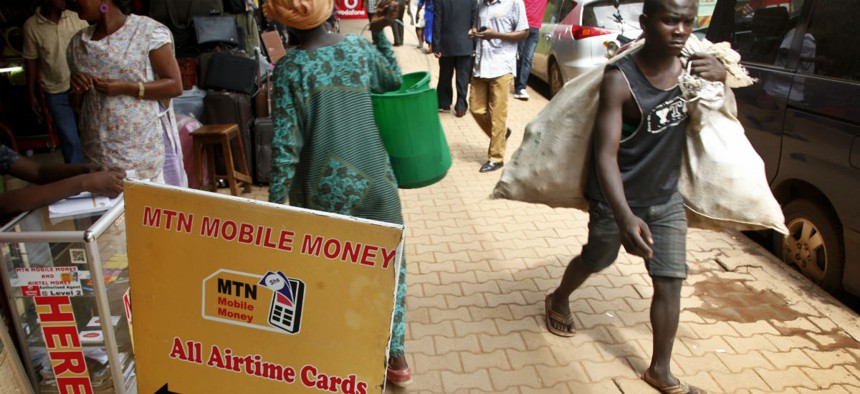If You Want Affordable Internet in Africa, Move to a Country on the Coast

Pedestrians walk past a mobile money point in Kampala, Uganda. Stephen Wandera/AP
In sub-Saharan Africa, a major obstacle that keeps millions from achieving universal digital access is geographical location.
The rapid spread of 3G mobile broadband networks has meant that 84 percent of the world’s population can now potentially access the web, and almost half of the world did so by the end of last year, according to the International Telecommunication Union.
The other half—predominantly in developing countries—continues to be kept offline by high data costs, inadequate digital infrastructure, achingly-slow download speeds and a scarcity of content in local languages.
In sub-Saharan Africa, a major obstacle that keeps millions from achieving universal digital access is geographical location. Many landlocked African nations or rural areas that are far from cable landing stations struggle to access efficient and cost-effective networks.
This issue has been dubbed “the last 1,000 miles”, a play on the term “last-mile,” used in telecommunications to refer to the final chain of electronic infrastructure meant to connect end users at homes, schools and workplaces.
Users in landlocked countries in Africa pay on average $232 more per month for fixed broadband access than those living in coastal areas, according to the World Bank’s recent 2016 Digital Dividends report. As such, countries like Chad, Cameroon, Mali and Niger have some of the highest purchasing parity for every megabit per second.
In contrast, coastal countries like Ghana, South Africa, Mauritius, Gabon and Mauritania, have some of the cheapest internet prices on the continent. Even war-torn nations like Somalia have better access to the internet through their fiber optic link than stable, landlocked nations like Zambia and Lesotho.
Coastal areas benefit from the better internet connectivity provided by fiber cables. Even though satellites can work as a backup in low-connected areas, they are slower, more expensive and susceptible at times to bad weather. Prices for residential broadband services in landlocked countries like Chad and Lesotho can exceed $3,000 and $600 a month respectively, but dip to as low as $87 a month in Kenya, and $47 in Mauritius.
To overcome these types of logistical hurdles, companies like Facebook are planning to dispatch drone satellites to beam internet service across sub-Saharan Africa. In 2013, Google also launched Project Link to help providers connect more people to the internet. Given the company generates most of its revenue from ads, providing the infrastructure to connect more Africans could pay off.
Local companies across the continent have also been developing products aimed at addressing limited internet availability. Kenyan start-up BRCK built a rugged, self-powered modem for harsh environments with poor infrastructure. The BRCK has a 3G data-enabled SIM card slot, which can work in over 140 countries, connect 20 devices and stay powered for up to 8 hours if the electricity goes off.


